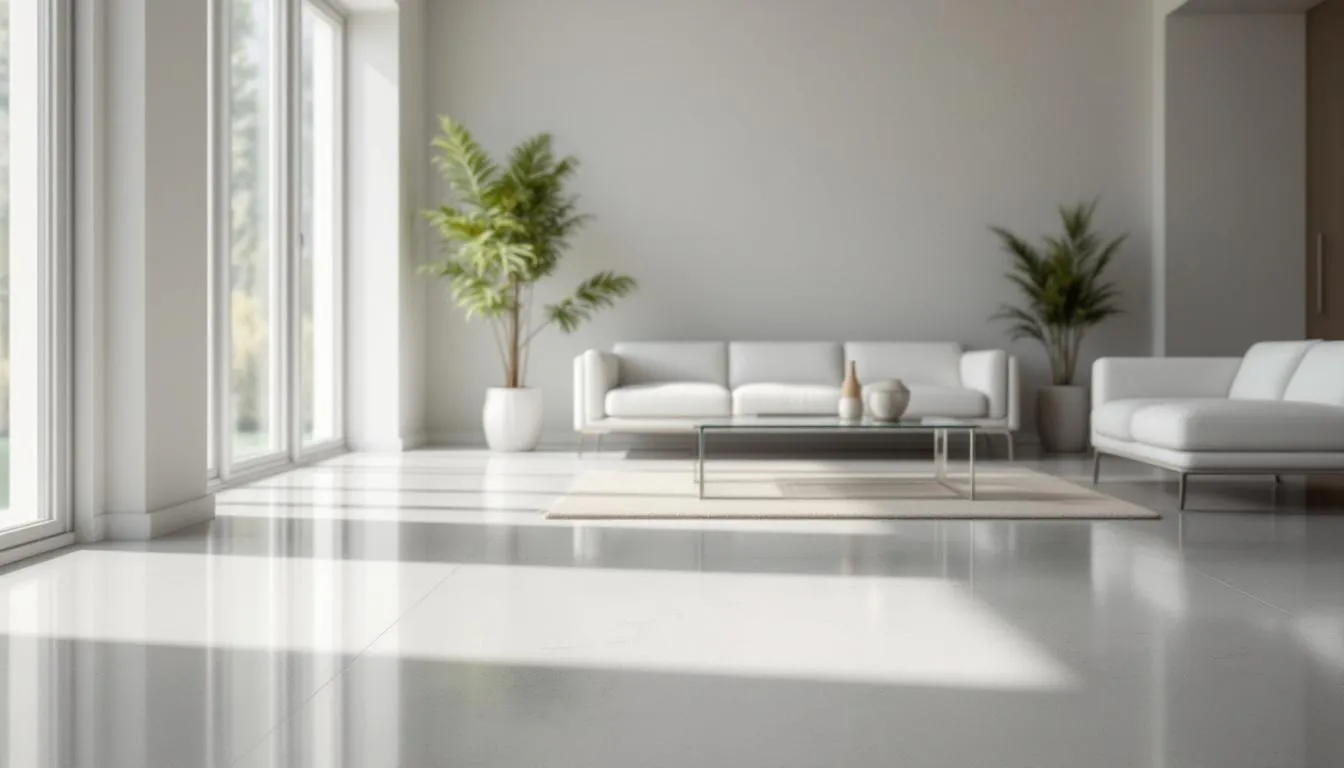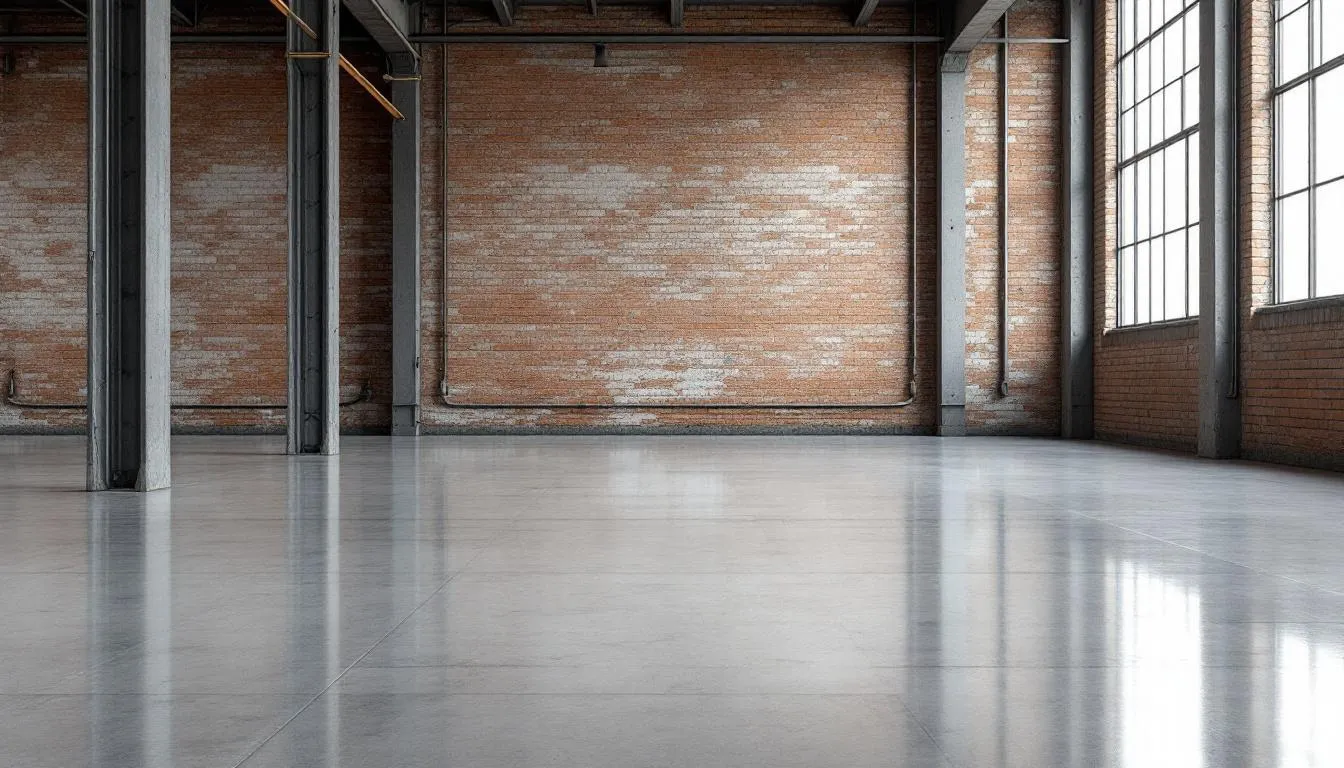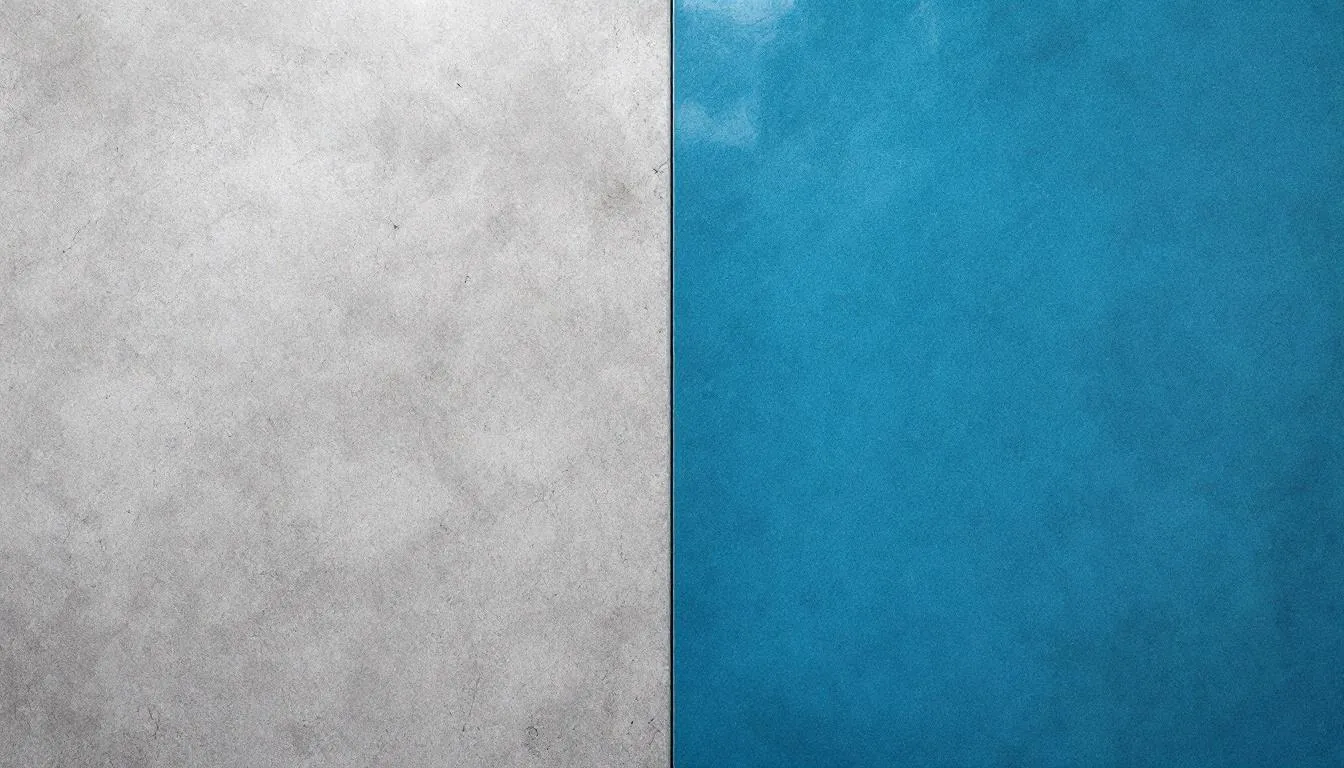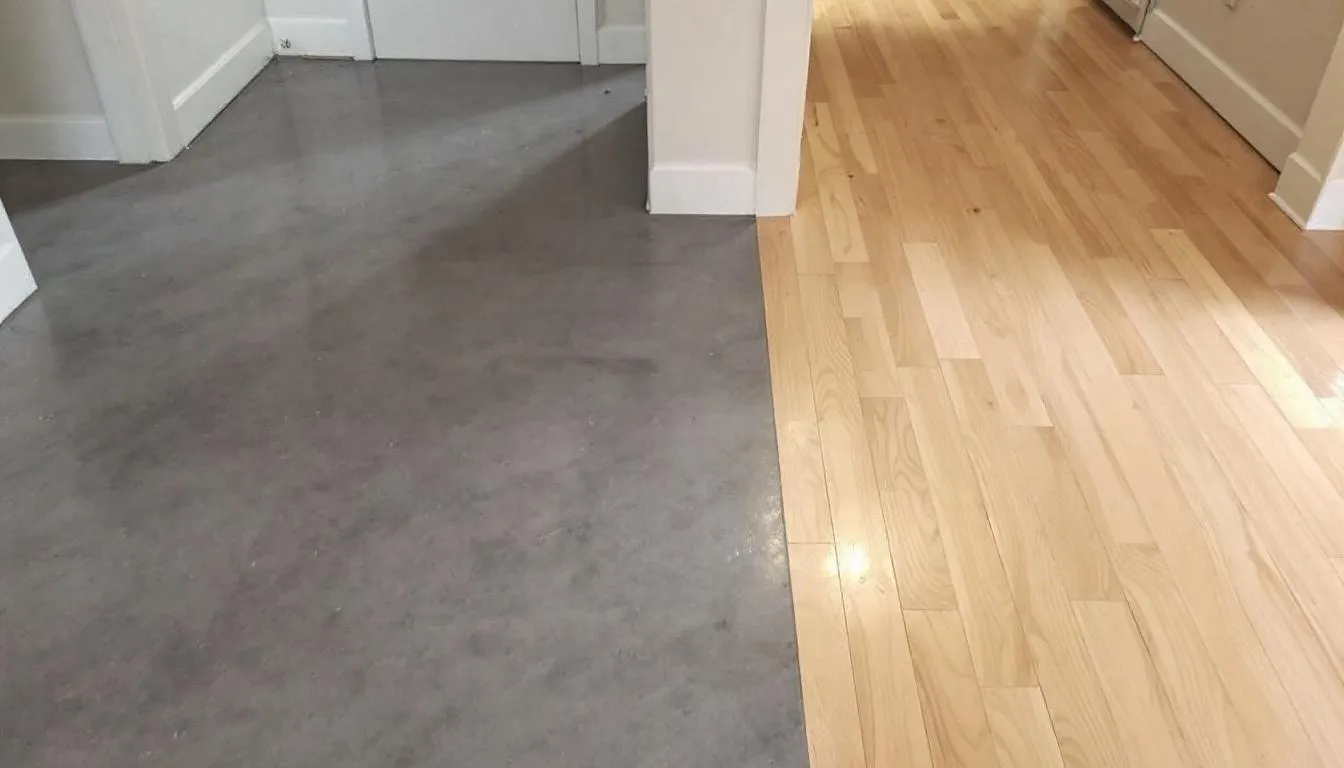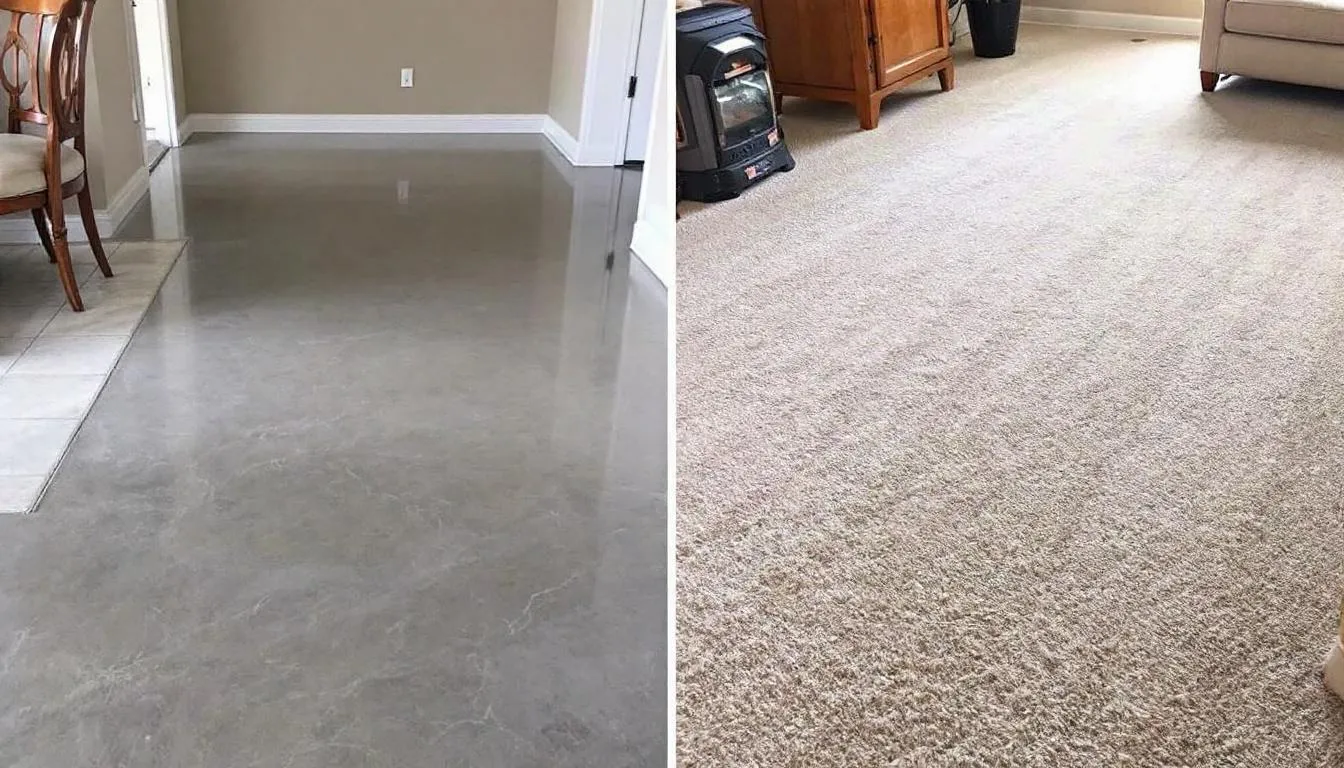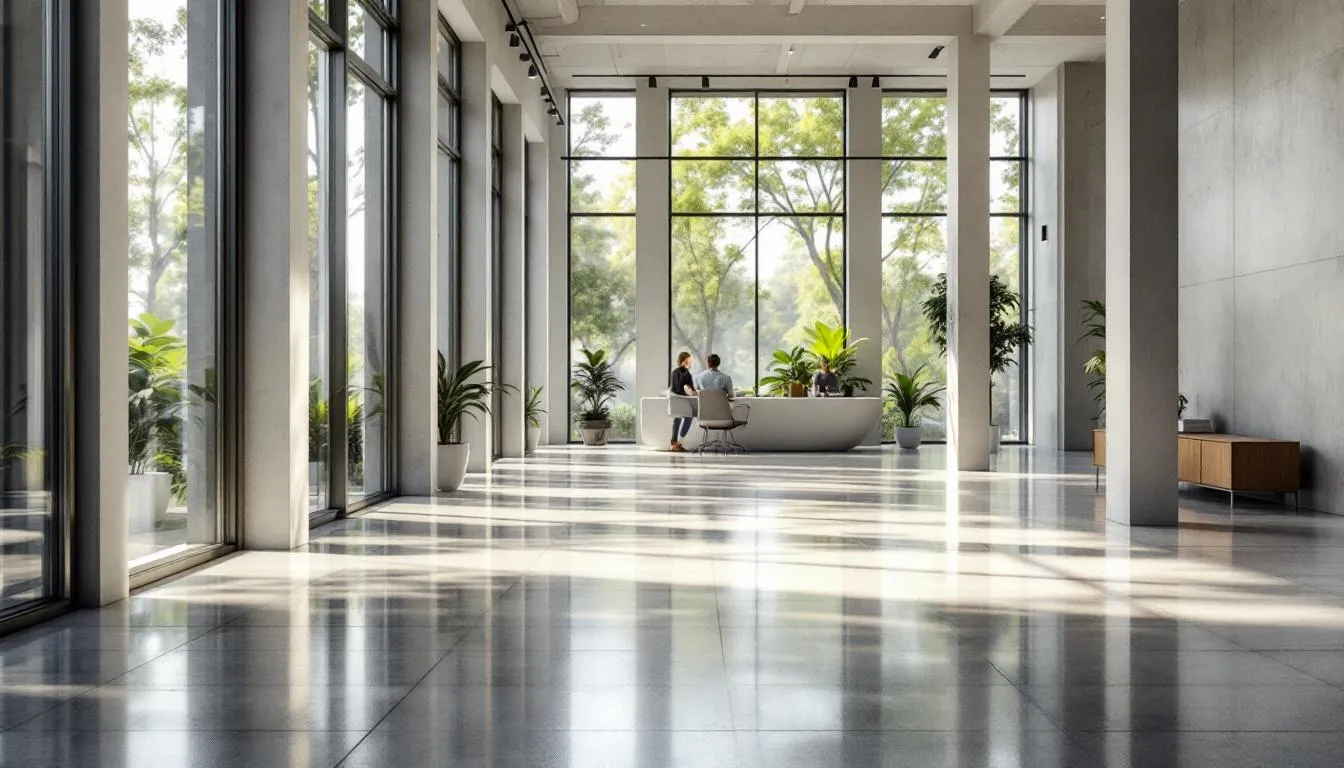Key Takeaways
- Polished concrete offers superior durability lasting 20+ years compared to most flooring materials that need replacement every 5-15 years
- While initial costs may be higher, polished concrete provides better long-term value with minimal maintenance requirements and no need for regular refinishing
- Polished concrete outperforms alternatives in sustainability, using existing concrete slabs and requiring no harsh chemicals or frequent replacements
- The versatility of polished concrete allows it to complement any design style while providing better moisture resistance than wood, carpet, or natural stone
- Unlike epoxy coatings that yellow and chip, or tiles that crack and require grout maintenance, polished concrete maintains its appearance with simple cleaning
When choosing flooring for your home or business, the decision extends far beyond initial appearance. The wrong choice can cost you thousands in premature replacements, ongoing maintenance, and lost productivity. With flooring materials ranging from traditional hardwood to modern epoxy systems, navigating your options requires understanding not just upfront costs, but long-term performance, durability, and total cost of ownership.
Polished concrete has emerged as a superior flooring solution that addresses the shortcomings of traditional flooring materials while delivering exceptional value over time. This comprehensive guide examines how polished concrete stacks up against every major flooring option, providing you with the data-driven insights needed to make an informed decision for your space.
What is Polished Concrete and Why Consider It?
Polished concrete is a flooring system created by mechanically grinding, honing, and polishing the surface of existing concrete slabs using progressively finer diamond abrasives. This polishing process transforms ordinary concrete into a smooth, glossy surface that reveals the natural beauty of the concrete’s aggregate and creates a sophisticated, stone-like finish. Additionally, polished concrete is highly resistant to heat and surface damage, making it a durable and practical choice for various environments.
The process begins with grinding the concrete surface to remove imperfections and expose the desired level of aggregate. Specialised chemical densifiers are then applied to harden and strengthen the surface. Finally, successive rounds of increasingly fine polishing bring the concrete floor to the desired level of gloss and smoothness.
Unlike surface coatings or overlays, polished concrete densifies and refines the actual concrete surface itself. This fundamental difference means the polished finish becomes an integral part of the concrete floor rather than a separate layer that can peel, chip, or wear away over time. However, achieving this level of quality requires professional installation to avoid cracks and ensure a flawless finish.
Since gaining popularity in the early 2000s, polishing concrete has expanded from industrial warehouses into retail spaces, commercial buildings, and residential homes. The aesthetic appeal of polished concrete, combined with its practical benefits, has made it an increasingly popular choice for property owners seeking a perfect flooring solution that balances style with performance.
Many property owners choose polished concrete for its slip resistance and traction, making it a safe flooring option even when the surface appears smooth and glossy.
In the following sections, we will compare polished concrete to other flooring options, highlighting its advantages in cost, style, and installation.
Design Flexibility and Options with Polished Concrete
One of the best things about polished concrete is how flexible it is with looks—you can use it pretty much anywhere, from your living room to busy shops and even garage floors. The polishing process lets you pick different shine levels, from a subtle matte finish to a proper high gloss mirror effect. This means you can match your concrete floor to exactly what you want, whether you are after something understated or a bold modern look that really pops.
Polished concrete gives you even more options with stains and dyes, which can add vibrant colours or keep things natural with earth tones. This lets homeowners and business owners create something unique that works with their décor and branding. You can also expose the aggregate in the concrete to make it look like natural stone or marble—you get that same appeal but for a fraction of the cost.
Beyond looking good, polished concrete offers a highly durable surface that takes a beating and is easy to keep clean in high traffic areas. This makes it perfect for commercial spaces, shops, and busy households. Whether you want to show off the natural beauty of your space or you need something practical that will last for years, polished concrete gives you that mix of style and performance that most other flooring options just cannot match.
Polished Concrete vs Epoxy Flooring
Epoxy flooring is a type of surface treatment applied over concrete to enhance durability, appearance, and performance, especially in industrial and commercial environments. When comparing polished concrete vs epoxy flooring, the differences in longevity and maintenance become immediately apparent. Epoxy floors consist of synthetic resins applied as an epoxy coating over existing concrete surfaces, creating a plastic-like finish that can initially look attractive but faces significant durability challenges over time. Epoxy flooring is also a popular choice for garage floors due to its protective qualities, but polished concrete is increasingly being considered for garages as well.
Durability and Lifespan
Polished concrete floors are highly durable and can last indefinitely when properly maintained, requiring only occasional re-polishing in high traffic areas. In contrast, epoxy flooring typically needs complete recoating every 5-10 years as the synthetic surface begins to yellow, chip, and wear through to the underlying concrete.
Appearance and Aesthetics
The natural beauty of polished concrete creates an authentic stone-like appearance that showcases the unique characteristics of the aggregate within the concrete. Epoxy floors, while available in various colours and patterns, maintain a distinctly artificial, plastic appearance that can look dated over time.
UV Resistance
One of the most significant advantages of polished concrete over epoxy floors is UV stability. Polished concrete maintains its appearance indefinitely when exposed to sunlight, while epoxy coatings yellow and discolour when exposed to UV rays, particularly problematic in spaces with large windows or outdoor areas.
Maintenance Requirements
Maintaining polished concrete requires simple mopping with neutral cleaners, while epoxy floors are susceptible to scratches, chips, and hot tyre pickup that can create permanent damage requiring professional repair or complete recoating.
Cost Analysis
When considering epoxy flooring vs polished concrete, both have similar initial installation costs ranging from $30-120 per square metre, but there are key differences. Epoxy flooring generally has a shorter lifespan, requires more frequent maintenance, and needs to be completely recoated every 5-10 years, while polished concrete is more durable and cost-effective over a 20-year period.
Polished Concrete vs Natural Stone Flooring
Natural stone flooring options like marble, granite, and travertine have long been considered luxury flooring materials, but polished concrete offers similar aesthetic appeal at a fraction of the cost while often outperforming natural stone in practical applications.
Cost Comparison
Natural stone flooring typically costs $150-300 per square metre for materials alone, not including the specialised installation required. Polished concrete flooring achieves a similar high-end appearance for $30-120 per square metre, making it accessible for projects where natural stone would be prohibitively expensive.
Installation Complexity
Installing natural stone requires sourcing materials from quarries, often with long lead times and potential for variations in colour and pattern that may not match design expectations. Polishing concrete utilises existing concrete floors or can be installed with standard concrete placement techniques, providing more predictable scheduling and results.
Maintenance Requirements
Natural stone requires regular sealing to prevent staining and moisture damage, with some stones needing resealing annually. Polished concrete requires no sealing once the polishing process is complete, as the densification creates a naturally stain-resistant surface.
Durability Considerations
Both polished concrete and natural stone are designed to resist general wear, making them suitable for high-traffic or heavy-use environments. While natural stone can be extremely durable, it’s also susceptible to cracking from building settlement or thermal movement. Polished concrete offers similar scratch resistance but with greater flexibility to accommodate building movement without cracking, and it is easier to repair if general wear or damage does occur.
Consistency and Availability
Natural stone quarries can become depleted or change in appearance over time, making it difficult to match existing installations for repairs or additions. The polished finish of concrete can be replicated consistently using the same techniques and materials, ensuring long-term maintenance and expansion possibilities.
Polished Concrete vs Hardwood Flooring
The comparison between polished concrete and hardwood flooring reveals significant advantages for concrete in terms of moisture resistance, maintenance requirements, and long-term durability, particularly in environments where traditional hardwood faces challenges.
Moisture Resistance
Polished concrete excels in areas prone to humidity and moisture damage, making it ideal for kitchens, bathrooms, and basements where hardwood flooring would be vulnerable to warping, cupping, and deterioration. Concrete floors handle moisture exposure without structural damage or dimensional changes.
Maintenance and Refinishing
Hardwood floors require sanding and refinishing every 7-10 years to maintain their appearance, a process that’s dusty, time-consuming, and expensive. Polished concrete floors maintain their appearance through simple cleaning, with only occasional re-polishing needed in extremely high traffic areas after many years of use.
Allergen and Dust Considerations
Wood flooring can harbour dust mites and allergens in the grain patterns and small gaps between boards. The seamless nature of polished concrete creates a surface that doesn’t trap allergens and can be easily cleaned to maintain healthy indoor air quality.
Lifespan Comparison
Quality hardwood flooring can last 15-20 years before requiring replacement, while properly maintained polished concrete can provide decades of service. The concrete surface actually becomes harder and more durable over time, while hardwood gradually shows wear patterns and scratches that become increasingly difficult to repair.
Environmental Impact
Polished concrete utilises existing concrete slabs rather than requiring harvesting of trees or manufacturing of new materials. This approach significantly reduces the environmental impact compared to hardwood flooring, which requires cutting trees and often involves chemical treatments for preservation. By refining the existing concrete slab, polished concrete minimizes the need for additional materials, further enhancing its sustainability.
Polished Concrete vs Ceramic and Porcelain Tiles
The choice between polished concrete and ceramic or porcelain tiles often comes down to maintenance requirements, installation complexity, and long-term performance under various conditions.
Grout Maintenance
The most significant advantage of polished concrete over tile flooring is the elimination of grout lines. Tile installations require regular grout cleaning, sealing, and eventual replacement as grout deteriorates over time. In fact, ceramic and porcelain tiles often require specialised machines or chemicals to properly clean grout and tile surfaces, whereas polished concrete can be maintained with simple cleaning methods. The seamless nature of polished concrete eliminates these ongoing maintenance requirements while providing a more hygienic surface.
Cracking and Settlement
Ceramic and porcelain tiles are brittle materials that can crack when buildings settle or experience thermal movement. Individual tiles may need replacement, often requiring removal of surrounding tiles to access damaged areas. Polished concrete can accommodate building movement without cracking, and if minor surface damage occurs, it can be addressed through localised re-polishing.
Installation Time and Complexity
Installing tile flooring requires careful placement of individual tiles, precise spacing, grouting, and curing time that can extend the installation process over several weeks. The polishing process for concrete can typically be completed in 3-5 days, minimising disruption to business operations or home life.
Slip Resistance
While glazed tiles can become slippery when wet, polished concrete can be treated with specific techniques to increase traction without compromising the aesthetic appeal. The ability to customise slip resistance makes polished concrete suitable for both dry and potentially wet environments.
Design Consistency
Tile installations can suffer from colour variations between batches, lippage between tiles, and grout lines that may become discoloured over time. Polished concrete provides a uniform appearance across the entire installation that maintains consistency over the life of the floor.
Polished Concrete vs Vinyl Flooring
Vinyl flooring has gained popularity as an affordable alternative to traditional flooring materials, but when compared to polished concrete, significant differences emerge in durability, environmental impact, and long-term cost effectiveness.
Durability Under Heavy Traffic
Polished concrete is engineered to withstand wear from heavy loads and high volumes of foot traffic, making it ideal for busy commercial and industrial spaces. It easily handles heavy foot traffic, rolling loads, and equipment without showing wear patterns or damage. Vinyl flooring, while initially attractive, shows traffic patterns, scuff marks, and indentations from furniture or equipment that become permanent over time.
Environmental Considerations
Vinyl flooring is a synthetic material that can release volatile organic compounds (VOCs) into indoor air, potentially affecting indoor air quality. As a natural material, polished concrete produces no harmful chemicals and actually improves indoor air quality by eliminating dust and allergen accumulation.
Authentic vs Artificial Appearance
Modern vinyl flooring often attempts to mimic the appearance of wood, stone, or other natural materials, but the printed patterns and textures rarely convince under close inspection. The natural beauty of polished concrete showcases authentic aggregate patterns and creates genuine stone-like aesthetics that improve with age.
Longevity and Replacement Cycles
Vinyl flooring typically requires replacement every 10-15 years as it wears through, tears, or becomes outdated. This replacement cycle means multiple installations over the lifetime of a building, while polished concrete represents a permanent flooring solution that can last the life of the structure.
Temperature Stability
Vinyl flooring expands and contracts significantly with temperature changes, potentially creating gaps or buckling. Concrete’s thermal mass provides stability and can even help regulate indoor temperatures, while the polished surface maintains its appearance regardless of temperature fluctuations.
Polished Concrete vs Carpet Flooring
The comparison between polished concrete and carpet reveals fundamental differences in hygiene, maintenance requirements, and suitability for various environments, with concrete offering superior performance in most commercial and many residential applications.
Hygiene and Indoor Air Quality
Carpet fibres trap dust, allergens, pet dander, and bacteria that can be difficult to remove even with professional cleaning. The smooth, non-porous surface of polished concrete eliminates these hiding places for contaminants, making it easy to maintain clean, healthy indoor environments. Additionally, polished concrete does not support the growth of molds, offering a hygienic advantage over wood and some tile options.
Maintenance Requirements
Carpet requires regular vacuuming, periodic deep cleaning, and professional treatment for stains and odours. Polished concrete needs only simple mopping with neutral cleaners, eliminating the time and expense of carpet maintenance while providing consistently clean results.
Moisture and Spill Response
Liquid spills on carpet can create permanent stains and provide breeding grounds for mould and bacteria, particularly in high-humidity environments. The water-resistant nature of polished concrete means spills can be immediately cleaned without lasting damage or hygiene concerns.
Lifespan and Replacement
Carpet typically requires replacement every 5-10 years as it shows wear patterns, stains, and odour accumulation that cannot be remedied through cleaning. Polished concrete provides decades of service without the need for replacement, making it more cost effective over time despite higher initial installation costs.
Pet-Friendly Characteristics
For spaces that accommodate pets, polished concrete offers significant advantages over carpet. The scratch-resistant surface withstands pet claws, while the easy-to-clean surface simplifies accident cleanup and prevents odour absorption that can be permanent in carpet installations.
Cost Analysis: Long-Term Value Comparison
Understanding the true cost of flooring requires looking beyond initial installation prices to consider the total cost of ownership over 20 years, including maintenance, repairs, and replacement cycles.
Initial Installation Costs (2024 Average Prices per Square Metre)
| Flooring Material | Installation Cost Range |
|---|---|
| Polished Concrete | $30-120 |
| Epoxy Flooring | $25-100 |
| Hardwood | $80-150 |
| Natural Stone | $150-300 |
| Ceramic/Porcelain Tile | $70-140 |
| Vinyl Flooring | $50-110 |
| Carpet | $50-110 |
The upfront cost of polished concrete may be higher than some alternatives, but this is offset by its durability, low maintenance, and long-term savings.
20-Year Ownership Costs
When calculating long-term costs, polished concrete demonstrates superior value despite potentially higher upfront investment:
- Polished Concrete: $30-120 initial + $2-5 annual maintenance = $70-220 total
- Carpet: $50-110 initial + $10-20 annual maintenance + $100-220 replacement (years 7, 14) = $320-570 total
- Hardwood: $80-150 initial + $5-10 annual maintenance + $30-50 refinishing (years 8, 16) = $240-370 total
- Vinyl: $50-110 initial + $3-8 annual maintenance + $100-220 replacement (year 12) = $210-448 total
These calculations clearly show that despite higher initial costs, polished concrete provides the best long-term value through eliminated replacement cycles and minimal maintenance requirements.
Cost Savings Examples
A 200 square metre commercial space choosing polished concrete over carpet could save money over 20 years:
- Carpet total cost: 200 × $400 average = $80,000
- Polished concrete total cost: 200 × $145 average = $29,000
- Total savings: $51,000 over 20 years
Installation and Maintenance Considerations
The installation process and ongoing maintenance requirements significantly impact the total cost and convenience of any flooring choice, with polished concrete offering advantages in both areas.
Installation Timeline Comparison
Polished concrete installation typically requires 3-5 days for completion, including grinding, densifying, and final polishing stages. This compares favourably to:
- Tile installation: 1-3 weeks including substrate prep, installation, grouting, and curing
- Hardwood installation: 1-2 weeks including acclimation, installation, and finishing
- Carpet installation: 1-3 days but requires furniture removal and replacement
Maintenance Requirements
The maintenance requirements for polished concrete are minimal compared to other flooring materials:
Weekly Cleaning: Simple dust mopping or damp mopping with neutral pH cleaners maintains the polished finish without special equipment or techniques.
Periodic Maintenance: Depending on foot traffic levels, polished concrete may benefit from professional cleaning and light re-polishing every 5-10 years in high-traffic commercial spaces, or every 10-20 years in residential applications.
Repair Options: Minor scratches or surface damage can be addressed through localised re-polishing without replacing entire sections, unlike tile or hardwood repairs that often require removing and replacing substantial areas.
Professional Installation Importance
While some flooring materials can be installed by skilled DIYers, polished concrete requires professional installation with specialised equipment and expertise. The initial investment in professional installation ensures optimal results and maximises the lifespan of the floor.
Common Misconceptions and Myths About Polished Concrete
You might have heard a few things about polished concrete that put you off the idea. Let’s sort out the facts from the fiction so you can make a smart choice for your floors.
First up, the myth that polished concrete is cold and unwelcoming. That’s just not true. Polished concrete can actually radiate heat beautifully, especially when you pair it with underfloor heating. You’ll get a comfortable, inviting surface that works well even when the weather turns cool. It’s a smart choice that looks good and feels right. However, it’s worth noting that polished concrete does provide a hard and cold surface, which can be less comfortable in colder climates without additional heating solutions.
Another story doing the rounds is that polished concrete can’t handle humidity and moisture. Wrong again. Sure, untreated concrete can cop a beating from moisture, but properly done polished concrete is tough as nails when it comes to humidity and water damage. The densification and sealing that happens during polishing protects the surface big time. You can use it in kitchens, bathrooms, and any other spot where moisture might be an issue.
Some people reckon polished concrete is high maintenance. Actually, it’s the opposite. Polished concrete is famous for being low maintenance. A quick sweep with a dust mop or a clean with neutral cleaner is usually all that’s needed to keep it looking sharp. No waxing, no sealing every year, no constant refinishing. It’s practical for homes and commercial spaces alike.
When you understand what polished concrete really offers, you can choose your flooring with confidence. You’ll get a surface that’s not just beautiful and durable, but also dead easy to look after and maintain.
Real-World Applications and Case Studies
Polished concrete floors really do the job in all sorts of real situations, from your everyday home right through to busy commercial spots that cop a hammering. In houses, you can throw polished concrete into living areas, kitchens, and even downstairs spaces and you’ll get sleek, modern floors that are dead easy to keep clean. The smooth surface looks the goods in open-plan areas where it makes the space feel bigger and brighter.
When it comes to commercial spots, polished concrete gets picked because it can handle the daily grind of high-traffic areas like shops, cafes, and office buildings. It’s tough as nails and doesn’t need much looking after, which means you’ll save a fair bit over time since you won’t be constantly fixing or replacing it like other floor options. One flooring study found that businesses with polished concrete floors spent less on upkeep and got floors that lasted longer, helping them keep more money in their pocket.
Safety’s another big plus that shows up in real jobs. Studies reckon that polished concrete can be finished to give you better grip, which cuts down on slips and falls in busy places. This makes it a ripper choice for commercial settings where you need to tick the safety boxes and keep everyone happy.
These examples and real-world cases show that polished concrete isn’t just about looking good – it’s a practical and cost-smart solution that works across all sorts of spaces and uses.
Environmental Impact and Sustainability
Environmental considerations increasingly influence flooring decisions, and polished concrete offers significant sustainability advantages over most alternative flooring materials.
Use of Existing Materials
The most significant environmental benefit of polished concrete is its use of existing concrete slabs rather than requiring new materials. This approach eliminates the energy consumption and carbon emissions associated with manufacturing new flooring materials.
Carbon Footprint Comparison
Manufacturing synthetic flooring materials like vinyl, carpet, and even harvesting and processing hardwood creates substantial carbon footprints. Polishing existing concrete surfaces requires minimal additional materials and energy consumption compared to these alternatives.
End-of-Life Considerations
When buildings are eventually demolished, polished concrete can be crushed and recycled as aggregate for new concrete projects. This contrasts with synthetic materials like carpet and vinyl that typically end up in landfills, and even hardwood that may not be suitable for reuse after decades of installation.
Indoor Air Quality
Polished concrete produces no volatile organic compounds (VOCs) or off-gassing that can affect indoor air quality. Many other flooring materials, particularly synthetic options, can continue releasing chemicals into indoor air for years after installation.
Water Usage and Chemical Requirements
Maintaining polished concrete requires only water and mild, neutral cleaners. Compare this to carpet cleaning that often requires harsh chemicals, or the chemical sealers and treatments needed for natural stone and hardwood maintenance.
Making the Right Choice for Your Space
Selecting the right flooring involves considering your specific needs, budget, and long-term goals. Polished concrete offers particular advantages in certain applications while addressing common concerns that might influence your decision.
Ideal Applications for Polished Concrete
High Traffic Areas: Commercial spaces, retail environments, and busy households benefit from the durability and easy maintenance of polished concrete flooring.
Modern Design Preferences: The clean, minimalist aesthetic of polished concrete complements contemporary architecture and interior design trends.
Moisture-Prone Environments: Kitchens, bathrooms, basements, and commercial spaces where spills or humidity are concerns benefit from the moisture resistance of concrete floors.
Existing Concrete Opportunities: Buildings with existing concrete slabs present ideal opportunities for polished concrete installation without the need for substrate preparation.
Addressing Common Concerns
Temperature Concerns: While concrete can feel cool underfoot, this can be addressed through radiant heat systems installed beneath the concrete surface, or through area rugs in living areas where warmth is desired.
Slip Resistance: Properly finished polished concrete can include surface treatments to increase traction without compromising appearance, making it suitable for areas where slip resistance is important.
Acoustic Considerations: The hard surface of polished concrete can increase sound transmission, but this can be managed through architectural design, area rugs, or acoustic treatments in ceiling and wall materials.
Professional Consultation Benefits
Working with experienced polished concrete contractors ensures proper assessment of your existing concrete floor condition, appropriate polishing techniques for your specific needs, and customisation options that can address aesthetic preferences and functional requirements.
The versatility of the polishing process allows for various levels of aggregate exposure, sheen levels, and decorative treatments that can complement any design style while maintaining the practical benefits of polished concrete.
FAQ
Is polished concrete cold underfoot and can it be combined with radiant heating systems?
Polished concrete can feel cool to the touch, but this characteristic can actually be beneficial in warm climates for natural cooling. For areas where warmth is desired, radiant heating systems can be installed beneath the concrete surface before polishing, providing comfortable floor temperatures while maintaining all the benefits of polished concrete. The thermal mass of concrete also helps distribute heat evenly throughout the space.
How does polished concrete perform in climates with freeze-thaw cycles compared to other flooring options?
Polished concrete performs exceptionally well in freeze-thaw climates because the densification process during polishing reduces porosity and prevents water infiltration that could cause damage. Unlike ceramic tiles that can crack from freeze-thaw cycles, or hardwood that can expand and contract dramatically, properly installed and polished concrete maintains its integrity through temperature variations. The key is ensuring proper installation with appropriate expansion joints.
Can polished concrete be installed over existing flooring materials or does it require concrete substrate?
Polished concrete requires an actual concrete substrate to achieve proper results. It cannot be applied over existing wood, tile, or carpet flooring. However, if you have an existing concrete floor covered by other materials, those materials can be removed to expose the concrete for polishing. In some cases, a new concrete overlay can be poured over existing floors if the structural conditions allow, but this requires professional assessment.
What customisation options are available with polished concrete that other flooring materials cannot offer?
Polished concrete offers unique customisation through exposed aggregate levels, from minimal exposure showing mostly cement paste to full exposure revealing large decorative aggregates. Acid stains and dyes can create virtually any colour, while saw-cut patterns can mimic tile layouts or create geometric designs. The level of gloss can be adjusted from matte to high gloss mirror finishes. Decorative aggregates like glass, metal, or coloured stones can be seeded into the surface during installation for truly custom appearances that other materials cannot replicate.
How does the resale value impact compare between homes with polished concrete versus traditional flooring materials?
Polished concrete generally maintains or increases property values, particularly in modern or industrial-style homes where it’s viewed as a premium feature. Unlike carpet or vinyl that may be seen as outdated by potential buyers, polished concrete is viewed as a permanent, low-maintenance improvement. The timeless elegance and easy maintenance appeal to buyers concerned about ongoing flooring costs. In commercial properties, polished concrete is often preferred by tenants for its durability and professional appearance, potentially increasing rental values and reducing vacancy periods.


